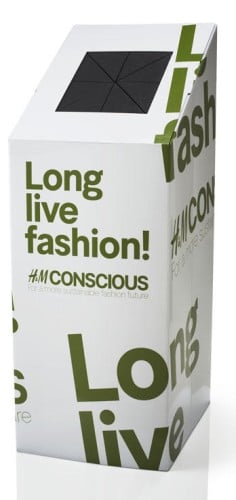Fast-fashion brands launch eco-initiatives - but are they serious?
Fast-fashion brands are rolling out the green carpet with a range of eco-initiatives, but is it just a cynical marketing ploy

It's continually inventive and often glamorous but, with the exception of labels such as Stella McCartney and Edun that wear their eco-consciousness on their sleeve, the fashion business is not known for its attention to environmental issues.
Yet in the past five years, companies from Adidas to Valentino and Zara have been acquiring a green tinge through an array of initiatives.
Some have begun using recycled materials in their products, others initiated recycling drives for used clothing and introduced labels that detailed the carbon footprint of their items. All these measures have typically been launched with great fanfare.
But do they reflect a changing mindset and advance towards sustainability in the industry, or are they simply marketing exercises designed to appeal to shoppers' consciences at a time of heightened eco-awareness?
Much of the scrutiny has been on the colossuses of so-called fast-fashion brands, such as Zara, H&M and Forever 21, whose trendy, inexpensive items seem designed for obsolescence, to be replaced every few months by the latest styles. Although many brands spout the green message, environmentalists question whether a business model based on disposable fashion is capable of truly being environmentally friendly.

H&M certainly seems an unlikely champion of sustainable clothing production. Yet since introducing an organic cotton line in 2007, the Swedish retail giant has become one of the world's leading users of this material.
"By 2020 we aim for all the cotton we use to be organic or recycled cotton," says Catarina Midby, H&M's head of fashion and sustainability.
Its Conscious Collection uses environmentally friendly fabrics made from organic cotton, cellulose fibre and even recycled plastic bottles. The brand also used lower-impact water-based solvents to make nearly 2.5 million pairs of shoes last year.
Midby bristles at the notion that its products are inherently unsustainable because they are inexpensive. "It is a misconception that affordable products cannot be sustainable. We maintain affordable prices by having small mark-ups, buying in large volumes, having effective logistics, having no middlemen, designing the products ourselves and having our own stores ... you need resources which smaller companies may not have," she says.
All the same, Midby concedes that the company's various eco-initiatives are only the start of a long-term process. That is why, she explains, "we don't say sustainable but more sustainable".
Responding to criticism that fast-fashion brands encourage excessive consumption by flooding the market with garments that are quickly and cheaply replaced, H&M recently launched a clothing recycling campaign. Shoppers who bring used or unwanted H&M garments into a branch for recycling can receive a discount on their next purchase.
Midby says the goals are clear: "Customers can save natural resources and contribute to reducing the environmental impact by avoiding textile waste."

"It's like saying 'Bring back the clothes that you don't want and we'll give you 10 per cent off so you can buy more clothes' ... but the problem is, ultimately, that we don't need to consume as much. In a way, fast-fashion completely destroyed the idea of having a wardrobe that you cherished."
Still, eco-fashion activists agree it is vital to change practices at the biggest clothing firms to bring in real change.
Christina Dean, the founder of Redress, an NGO dedicated to reducing waste in the fashion industry, has had success partnering with such firms.
The NGO helped Esprit conduct a thorough audit of its environmental impact. Since then the company has focused on reducing its carbon footprint by switching to more environmentally friendly dyeing and finishing processes and using more recycled and sustainable materials.
Another major step forward was the setting up the Zero Discharge of Hazardous Chemicals Group (ZDHC) in 2011.
A coalition of various clothing and footwear brands, including Levi Strauss, Gap, G-Star Raw, Inditex Group (the parent company of the Zara chain), Nike, Puma and Li-ning, it unites traditional competitors for a common purpose - to eliminate the discharge of hazardous chemicals such as azo dyes, heavy metals, and chlorophenols from their production processes by 2020.
Inditex also aims to reduce its carbon dioxide emissions by 10 per cent by 2015, and by 20 per cent by 2020 from 2005.
Margaret Kutt, manager of sustainable projects for Esprit, a ZDHC member, sees major companies as the best hope for sustainable fashion.
"It is precisely the large fashion companies that can bring about change and make the biggest contributions towards the preservation of the environment," she says. "The scale of manufacturing today has a direct impact on everything from water use to emissions and the demands we make on our suppliers can, and does, promote change."
With an estimated 80 billion garments made around the world each year from unrecycled materials, small changes in various production stages, from cotton growing to dyeing, could have a huge impact. About one quarter of the pesticides applied in the US, for example, is used to grow cotton, mainly for clothing.
According to US-based Cotton Incorporated, although just 33 per cent of consumers are likely to seek out green clothes, 69 per cent would be upset if they found out an item they bought was bad for the environment. And 40 per cent of consumers say they would blame the manufacturer if a piece of apparel was found to have been produced in a non-environmentally friendly way.
Despite their greater eco-awareness, shoppers aren't always willing to switch to more sustainable products, or pay more for them, even if they do say they want greener goods.
Consider Timberland's Green Index. The brand puts a tag on each product outlining its resource consumption, chemicals used and climate impact, and assigns a sustainability score - the higher the score the worse the product is for the environment.
The index was launched in 2007 in conjunction with its Earthkeepers line of boots and jackets, which are made from environmentally responsible materials, such as recycled polyethylene terephthalate - the plastic used to make water bottles. When the line was launched it had a rating of 8.5, but now includes products with a rating as low as 3.5.
With the Earthkeepers line contributing 60 per cent of the company's revenues last year, it is the company's fastest growing line, indicating a real market for sustainable fashion.
However, the brand's most popular product, its trademark yellow boot, still has the worst sustainability rating, suggesting that customers don't want the company to mess with classics.
"Consumers want endless choice. They want a product when they want it; they want it to be the way they want it and they want to pay a certain price for it," says Stewart Whitney, managing director for Timberland Asia Pacific. "But they also want companies who do the right thing. There's an expectation of sustainability."
However, customers insist the greener products feel and perform the same way as the conventional items and that they cost the same price, too.
There is no question that there has been a significant growth in the number of customers who care about sustainable fashion.
In the year since A Boy Named Sue was launched in Hong Kong, 10 other similar online boutiques have sprung up, Reinert-Shchelkanovtseva says. But nine of these start-ups are based in the US and one is in Britain, indicating that most of the interest in sustainable fashion comes from the West.
Even as Asia surpasses the US to become the world's largest retail market, the region has been fairly slow to embrace a more sustainable lifestyle.
"There's lots of research that says consumers want something sustainable, they want eco-friendly, they want ethics. But that research is looking at an educated market," says Dean. "We're a long way off before the younger generation in Asia starts changing the way they buy."